Essential Kitesurf Repair Kits for Every Kiteboarder
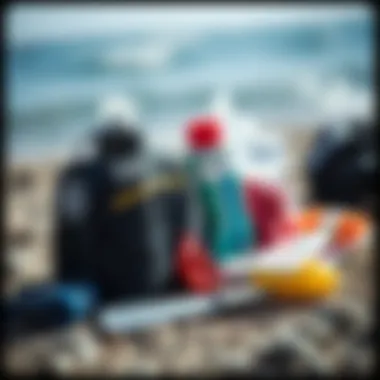
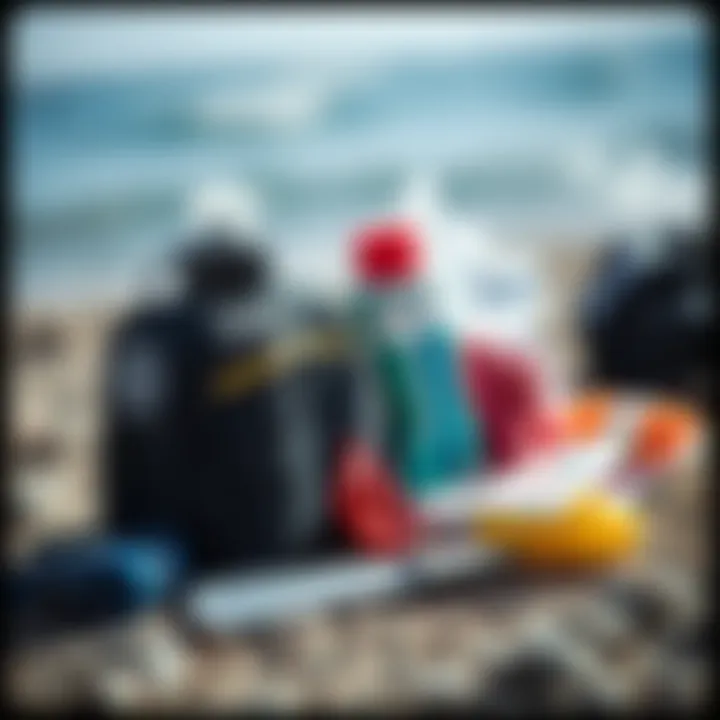
Intro
Kitesurfing brings a rush like no other, offering both freedom and adventure on the water. However, such thrills aren't without risks. Equipment can wear out, get damaged, or even fail, often at the most inconvenient times. That’s where a kitesurf repair kit becomes your best friend. Having the right tools and materials on hand can mean the difference between turning back to shore or continuing your session, wind in your hair and adrenaline pumping.
This guide serves to illuminate the importance of equipping yourself with a proper kitesurf repair kit, no matter if you're a seasoned rider or just starting out. We'll dive into the essential components of a repair kit, explore common types of damage you might encounter while kitesurfing, and offer practical tips to handle such situations effectively. Maintaining your gear is crucial, and so is knowing how to keep it in top shape for longer life and safety.
Whether you're assembling your own personalized kit, looking for recommendations, or seeking additional resources for repairs, this guide aims to provide you with the knowledge necessary to face any mishap confidently. Let's get started.
Prolusion to Kitesurf Repair Kits
Kitesurfing, an exhilarating blend of wind, water, and skill, presents a spectacular way to embrace the elements. However, like any adventurous sport, it isn't without its hiccups. Having a solid understanding of kitesurf repair kits not only serves the purpose of fixing equipment but also enhances the overall kitesurfing experience.
A well-equipped repair kit can be the difference between an enjoyable day on the water and an untimely return to shore. Equipment failures can occur when you least expect it, whether it’s due to wear and tear or an unfortunate mishap. This is where kitesurf repair kits come into play—they’re not just useful; they're essential for anyone who seeks to navigate the waves with confidence.
Understanding the Necessity of Repairs
Why should kitesurfers care about repairs? Imagine riding the wind, feeling the rush as you glide over the waves, only to find a tear in your kite. It can feel like a sinking ship, but with the right tools at hand, you can patch up and keep sailing.
Repairs ensure your gear remains safe and functional. Regularly addressing even minor damage prevents more severe issues down the line. When you're out in the water, a small rip can swiftly evolve into a larger tear if left uncontrolled. Knowing how to wield the tools in your repair kit empowers you to make quick fixes and resume your adventure.
This proactive approach doesn’t just save time; it could potentially save money as well. Making timely repairs prolongs the lifespan of your kitesurfing gear and helps avoid the cost of premature replacements.
Common Kitesurfing Mishaps
Every kitesurfer, from the casual weekend warrior to the seasoned professional, has experienced mishaps. Here are some of the typical issues that one might encounter:
- Tears in the Kite Canopy: The fabric of your kite is subject to wear and tear, especially during high-intensity use.
- Punctures in Bladders: Abrasions from sand or sharp objects can puncture the inflatable sections of your kite.
- Damaged Lines: Poor handling or entanglement can lead to frayed or broken lines, forcing a re-evaluation of your setup.
- Bar Clamps or Pushers: Accidental impacts can damage these parts, leading to potential control issues.
Repair kits designed for kitesurfing usually contain materials that target these common issues. Being aware of these mishaps and having a strategy to address them can turn a frustrating situation back into a day filled with adventure. After all, the last thing you want is to be sidelined when you could be carving up the surf.
Essential Components of a Kitesurf Repair Kit
Having a comprehensive kitesurf repair kit isn’t just a luxury; it’s a necessity for anyone serious about kitesurfing. The unpredictability of the ocean and common mishaps that happen out there can catch even seasoned surfers off guard. A properly equipped repair kit can mean the difference between a challenging day on the water and a catastrophic one. By arming yourself with the right tools and materials, you can ensure that your gear stays in top shape, allowing for more enjoyable sessions on the waves. Let’s break down the essential components of such a kit and explore how each plays a pivotal role in your kitesurfing experience.
Repair Materials
Ripstop Fabric
Ripstop fabric is a go-to choice for kitesurf repair and for very good reason. This material is specifically woven to prevent rips from expanding, which is crucial when you’re dealing with potential tears in your kite. The key characteristic of ripstop fabric is its durability, which means not only will it withstand the challenging conditions of kitesurfing, but it also offers reliable performance in various weather elements. One unique feature is the way it’s engineered; small, reinforced threads run through the fabric, creating a grid that enhances its resilience.
In terms of advantages, ripstop fabric is lightweight and easy to handle, making it seamless to patch up a tear quickly. However, it might not match all the colors or patterns of your kite, which could be a downside if you care about aesthetics. Still, in a pinch, it’s one of the most beneficial materials for effective repairs.
Adhesives
When it comes to kitesurfing repairs, high-quality adhesives are often the unsung heroes. They offer a strong bond that can withstand the strain of wind and water, ensuring your repairs hold tight even under pressure. The key characteristic of these adhesives is their flexibility, allowing them to move with the kite rather than cracking or breaking under stress.
These adhesives also come in various formulations, such as waterproof varieties specifically designed for outdoor use. One unique aspect is their quick curing time, which means you can make a repair and be back on the water in a short time. The only downside might be the necessity of proper application; getting it right the first time is crucial for effective bonding, and not following the instructions may lead to less than ideal results.
Sealing Tape
Sealing tape is another fundamental component of any kitesurf repair kit. It serves as an incredible solution for quick fixes that keep your kite functional in unexpected situations. The key characteristic of sealing tape is its water resistance, which is vital for katers operating in wet environments. It adheres well to different materials, making it versatile for various repairs on your gear.
A unique feature of sealing tape is its ease of application; it can be applied directly over the damaged area without the need for additional tools or liquids. It’s ideal for temporary repairs, allowing kiteboarders to extend their sessions even when faced with minor damage. However, it’s worth noting that tape may not provide a long-lasting solution and is best for quick fixes until you can implement more permanent repairs.
Tools Required
Scissors
Scissors are an absolute essential in any kitesurf repair kit. Their primary role is straightforward, yet crucial: cutting fabric, tape, and any other materials needed for repairs. A good pair of scissors should be sharp and versatile; these can handle both small precision cuts for intricate patches as well as broader cuts for larger materials.
The key characteristic to look for in scissors is their durability. A well-constructed pair will last for multiple repairs, ensuring they remain effective when needed the most. An advantage of scissors is ease of use, requiring minimal effort regardless of the user’s experience level. However, it’s vital to keep them clean and well-maintained; otherwise, dull blades can lead to ragged cuts and ineffective repairs.
Measuring Tape


Measuring tape might seem like an afterthought, but it plays a crucial role in achieving effective repairs. Correct measurement ensures you cut the materials to precise dimensions, which enhances the quality of the patch. The key characteristics of measuring tape include flexibility and durability, which allows it to contour to the surfaces you’re measuring, whether it’s a kite or a piece of fabric.
Having this tool means you can avoid guesswork and make repairs that are not only functional but also aesthetically pleasing. The downside here is if you forget to double-check measurements; an incorrectly sized patch can create more problems than it solves, leading to further damage instead of a solution.
Utility Knife
A utility knife is another indispensable tool when it comes to kitesurf repairs. It's primarily used for slicing through tougher materials such as thick patches or tough lines. The key characteristic of a utility knife is its versatility; it can accommodate various blade types for different cutting needs, making it ideal for multiple repair tasks.
One major advantage is the precision it offers in cutting shapes and curves, which can be particularly useful when working with intricate patches on your kite. However, safety is a significant concern; mishandling can lead to accidents, so it’s important to use the utility knife with care and always ensure it’s stored securely when not in use.
Storage and Portability
The way you store your kitesurf repair kit can significantly impact its effectiveness. A mess of scattered tools and materials can lead to frustration when you need to make a quick fix out on the water. Therefore, organizing your kit should be a priority; whether you opt for a small tackle box or a dedicated pouch, ensure that each component is easily accessible. Storage solutions that provide compartments can help keep everything in order, making it a breeze to find what you need at a moment’s notice.
Additionally, portability is essential. Many kitesurfers travel far and wide to find the perfect waves; having a lightweight, portable repair kit can save you the hassle of lugging around unnecessary weight. Aim for a kit that’s compact yet comprehensive enough to handle any common repairs.
In summary, knowing the essential components of a kitesurf repair kit can drastically improve your experience on the water. By understanding the importance of each material and tool, you can approach repairs with confidence and minimize downtime when mishaps do occur.
Types of Damage and Repair Techniques
Understanding the various types of damage that can occur during kitesurfing is crucial for any kiteboarder. It provides insights into how to handle emergencies effectively. By familiarizing yourself with these damage types and their corresponding repair techniques, you’ll become more self-sufficient on the water, ultimately saving time and resources. This knowledge not only enhances your overall experience but also instills a sense of confidence as you tackle mishaps with assurance.
Tears and Punctures
Locating the Damage
Finding tears or punctures on your kite can feel like searching for a needle in a haystack. To begin with, it’s vital to conduct your inspection both meticulously and systematically. A thorough check involves looking over the entire canopy and seams while keeping an eye out for any irregularities, like a change in shape or stiffness.
The presence of light shining through a small hole is a clear indicator of damage. Locating these issues precisely is essential because it minimizes the chance of further complications. Not only does pinpointing the damage allow for quicker fixes, but it can also prevent residual problems later down the line.
Applying Patches
Once you’ve identified the damage, applying patches becomes a key process. The ideal patch for punctures and small tears usually consists of a strong ripstop material accompanied by a reliable adhesive. The ability to patch effectively is an invaluable skill, as it not only restores the integrity of the fabric but also prevents further tears from developing under stress.
Ensure you clean the area around the tear before applying a patch; this is instrumental in achieving a secure bond. Patching is not just a practical choice, but also a popular technique among kiteboarders because, when done right, it offers a durable and long-lasting solution.
Leaking Bladders
Identifying the Leak
Bladders serve a critical function in maintaining the structural integrity of your kite. Identifying a leak can sometimes be a frustrating undertaking, particularly if it’s a slow leak that doesn’t show itself immediately. A common trick is to submerge the bladder in water and look for air bubbles, which indicates the precise location of the leak.
Understanding the significance of pinpointing leaks quickly becomes apparent. The longer a leak goes unrepaired, the more trouble it can cause, potentially leading to a complete bladder failure while in use. Hence, knowing how to locate leaks becomes essential for any serious kiteboarder.
Repairing Bladders
After spotting the leak, the repair process often involves some patching material specifically designed for bladders. Using a dedicated repair kit allows for both a solid adhesion and flexibility required in high-tension contexts. Once repaired correctly, the bladder should return to its original function and allow for safe, uninterrupted riding.
This method is essential, as overlooking bladder issues can lead to both safety hazards and a complete lift in performance. It’s also quite rewarding, as you witness the results of your repair efforts immediately.
Damaged Lines
Assessing Line Condition
When it comes to the lines on your kite, regular assessment cannot be overstated. These lines undergo significant stress during rides, and a frayed or worn line could compromise your safety. Key indicators of line deterioration include visible wear, changes in texture, and breaking strands.
By regularly checking the condition of your lines, you ensure that any potential issues are caught early. If you keep a close eye, assessing your lines can become a routine part of your pre-riding checks, lending confidence and peace of mind when out on the water.
Replacing Lines
If you find that lines are significantly damaged, it’s crucial to replace them as soon as possible. This often involves cutting the old lines and attaching new ones that match the specifications of your kite. Using the appropriate lines is imperative, as options vary significantly in terms of strength, weight, and durability.
Replacing lines is both a practical and a necessary choice for any serious kitesurfer. It not only prolongs the life of your gear but also enhances safety, ensuring that your kite performs as intended when it matters most.
Ultimately, familiarizing yourself with these different damage types and repair techniques equips you with the knowledge to address issues before they escalate, thereby maximizing your time on the water.
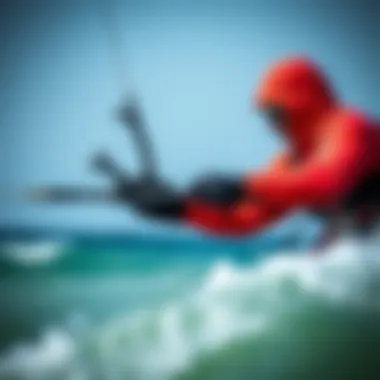

Delving into these various types of damage and repairs places you a step above others who might neglect their maintenance. A well-kept kite means fewer headaches on the water and a euphoric experience, knowing you are prepared for the unexpected.
Maintaining Your Kitesurf Gear
Kitesurfing is a thrilling sport that blends power and finesse, creating an exhilarating experience on the water. However, like any equipment, kitesurf gear needs regular maintenance to ensure it operates safely and efficiently. Proper maintenance can make the difference between a seamless day on the waves and an unwanted trip to the repair shop. It can also extend the life of your gear, ultimately saving you time and money in the long run.
Preventative Measures
When it comes to maintaining kitesurf gear, preventative measures are key. These are proactive steps that can help identify potential issues before they escalate into serious problems. Two critical aspects of preventative measures are regular inspections and proper storage.
Regular Inspections
Regular inspections are like routine check-ups for your kitesurfing gear. They serve as a preventive measure, ensuring that everything is in top shape before you hit the water. The main characteristic of regular inspections is their ability to catch problems early—think of it like a stitch in time saves nine. By routinely checking your equipment for wear and tear, you can often fix small issues before they become significant repairs.
One unique feature of these inspections is their adaptability; they can be performed at various frequency based on how often you kite surf or the conditions you often ride in. For instance, if you’re out frequently in harsh conditions, inspecting your gear before every session is beneficial. This approach can also unveil signs of damage, say, fraying lines or small tears in the kite, that might otherwise go unnoticed.
"A little diligence goes a long way. Catching an issue early can save a lot of hassle later."
Proper Storage
Proper storage of your kitesurf gear is another essential preventive measure that contributes to the longevity of your equipment. Keeping your gear in a clean, dry place protects it from unwanted environmental effects—like sunlight, which can weaken fabrics, or moisture that can lead to mildew. A characteristic of proper storage is its dual benefit: it keeps your gear safe and organized, making it easier to access when you’re ready for your next session.
A unique feature of proper storage methods is versatility. You might opt for a dedicated gear bag, or you could use a simple rack system in your garage or shed. The key is that the environment should be climate-controlled to some degree—extreme temperatures and humidity can deteriorate materials faster than you'd think. Just remember, improper storage can lead to unnecessary repairs and replacements, which can be a real bummer for kite enthusiasts.
Signs of Wear and Tear
Despite the best preventative measures, wear and tear are inevitable in kitesurf gear. Understanding the signs of wear can make all the difference in preventing costly repairs or, worse, gear failure while you’re out on the water.
Some common signs include:
- Discoloration: Fading color may indicate UV damage.
- Frayed lines: Thin areas or breaks are signs that it’s time to replace the line.
- Mildew or mold: This can appear as spots, especially if gear has been stored damp.
Being attentive to these signs not only saves money but also enhances safety while kitesurfing. After all, having functional and reliable equipment is essential for enjoying the sport to its fullest. So keep an eye out and don’t cut corners; your gear will thank you.
Creating Your Personalized Repair Kit
Crafting a personalized repair kit is like building a safety net, ensuring that when something goes wrong with your kite, you have not just a fix but the right fix. Every kitesurfer has unique needs based on their equipment, experience, and typical conditions faced while kiting. Therefore, creating a custom kit means you are well-prepared for whatever the ocean throws your way, making it an invaluable addition to your gear.
Assessing Your Needs
Before you gather your supplies, it's essential to take stock of your specific kitesurfing situation.
- Analyze your gear: Are you using a high-pressure inflatable or a foil kite? Each type requires different materials for repairs. Let's say you own a Wainman Hawaii kite, which blends both performance and fragility; a heavier-duty adhesive might be essential for any quick repairs on your outdoor excursions.
- Consider your riding style: Do you mainly cruise along with gentle winds, or do you relish the thrill of extreme conditions? The more aggressive your riding style, the more likely you might encounter problems in the field. This perspective can significantly affect what you need in your kit.
- Factor in the environment: Beach conditions, whether sandy or rocky, can impact durability. If you're often tearing through coastal reefs, including tougher repair materials is a no-brainer. Each factor tailors your kit to reflect both your riding habits and the conditions you face.
Essential Customizations
With a clear understanding of your requirements, the next step is customizing your repair kit to suit those specific needs. Remember, no two kitesurfers are alike. Here’s a tailored approach:
- Repair Materials: Start with essentials like durable patches and high-quality adhesives. If you tend to encounter tiny cuts or punctures, a roll of ripstop fabric will help patch up tears quickly and efficiently.
- Tools: You may want tools like scissors that are easy to use but also sufficiently sturdy, allowing a clean cut every time. A small utility knife offers versatility in cutting through different materials and can be a lifesaver.
- Storage Solutions: The way you store your kit matters just as much as what’s in it. Opt for compact, waterproof containers to keep your tools and supplies organized and protected from elements. A small, sturdy pouch that can be clipped onto your harness or packed away with an emergency flotation device can save you a headache at crucial moments.
"A stitch in time saves nine." This classic saying rings true in kitesurfing, where addressing small issues promptly can prevent larger, more costly damages down the line.
In summary, a personalized kitesurf repair kit is not merely about having the right tools but ensuring that those tools align with your unique needs and conditions. By thoughtfully assessing what you require and customizing your kit accordingly, you will enhance your resilience on the water and ultimately enjoy your kitesurfing experience even more.
Recommended Products for Kitesurf Repair Kits
When it comes to kitesurfing, having a solid repair kit can mean the difference between a fun day on the water and a frustrating experience. The products you choose should not only be effective but also trustworthy. In this section, we'll discuss essential products, their benefits, and things to keep in mind while selecting them.
High-Quality Adhesives
Adhesives are the backbone of any kitesurf repair kit. A good adhesive not only binds materials together but ensures durability under stress and exposure to water. Various types of adhesives, like cyanoacrylate or polyurethane, can be particularly effective.
- Water Resistance: When picking an adhesive, look for one specifically designed for marine use. This ensures it can withstand the moist, dynamic environment kitesurfers encounter.
- Flexibility: Your adhesive should remain flexible even after curing. Kites are under constant tension and movement, so a hard, brittle glue might crack and fail.
- Ease of Use: Some adhesives come in convenient applicators, making it easier to apply precisely where it's needed.
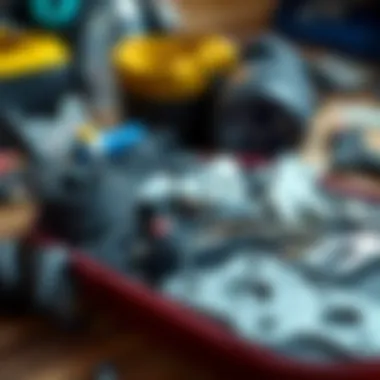
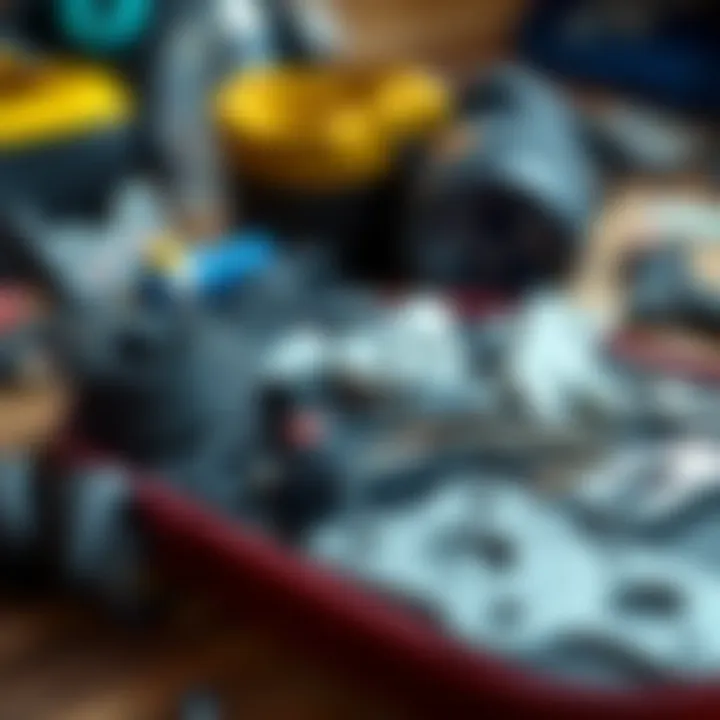
Furthermore, it's wise to check user reviews for each product. Sometimes, a recommendation from fellow kitesurfers can help steer you toward a hidden gem in adhesive options.
Durable Repair Tapes
Repair tapes serve a dual purpose: they can be used for temporary fixes on the go or as a part of permanent repairs. The right tape is crucial to ensuring that kitesurfing gear can withstand the pull of the wind and waves—you want something that’s rugged yet minimalistic.
Consider these factors when selecting repair tapes:
- Type of Tape: Look for tear-resistant and waterproof options. PVC or nylon-based tapes often provide excellent adhesion and durability.
- Width and Length: Depending on the common types of damage you encounter, having different widths can be helpful. A wider tape may cover big tears but be aware that it can add weight to the kite.
- Application Conditions: Some tapes require dry conditions for optimal adhesion, while others can be applied even when wet. Knowing the conditions under which you typically need to repair can guide your choice.
A solid tape, when applied correctly, can hold your kite together until you can conduct more thorough repairs at home.
Reliable Patching Materials
Patching is an art in itself—getting the right patch material can prolong the life of your kitesurfing gear. Choosing compatible materials and ensuring the integrity of the patch are essential elements of a good repair kit.
- Types of Patching Material: Often, ripstop nylon or polyester fabric works wonders for inserting patches. Not only are these fabrics lightweight, but they also resist tearing, making them ideal choices.
- Compatibility: Make sure the patch material matches the fabric of your kite, as mismatched materials may lead to further damage.
- Pre-Cut Pieces: Having pre-cut patches can save time and add convenience on the beach or wherever you find yourself needing a quick fix.
Lastly, always keep your patching materials organized and within reach. Whether it's tucked into a waterproof pouch or secured in your bag, knowing where to grab your patch can ease the stress of on-the-water issues.
"In kitesurfing, being prepared can make the difference between skillful maneuvers and a frustrating day of repairs. Prioritize quality in your products to ensure fun and safe experiences."
By focusing on these recommended products—high-quality adhesives, durable repair tapes, and reliable patching materials—kitesurfers can tackle mishaps effectively and confidently. Remember, it’s about maintaining the performance and longevity of your gear, so investing in the right products pays off in the long run.
For more guidance and discussions on repair techniques, check out resources like Reddit Stories or Kitesurfing Forums for community insights.
Learning More About Kitesurf Repairs
Understanding kitesurf repairs is vital for any kiteboarder, from beginners to seasoned pros. The unpredictability of the ocean and the wear and tear that comes with kitesurfing can lead to unexpected mishaps. Having a solid grasp of repair techniques not only ensures that you can get back on the water faster but also contributes to your overall safety while enjoying the sport.
Kites that remain in peak condition can significantly enhance your performance. Knowing how to repair your gear means you’ll spend more time buzzing across the waves and less time lurking on the beach waiting for a repair service. Ultimately, it reduces costs associated with professional repairs and prolongs the lifespan of your kitesurf equipment, which is a win-win for any kiteboarding enthusiast.
Additionally, it's important to recognize that not all repairs can be done immediately on the water. Some may require a deeper knowledge of kite structure and material properties. Thus, becoming adept at kitesurf repairs allows for a more nuanced understanding of your gear. People often overlook this element, but knowing the ins and outs of your own kit can greatly enhance your overall experience.
"An ounce of prevention is worth a pound of cure."
This old adage holds true in the kitesurfing world too; taking the time to learn about repairs now can prevent much bigger issues later. As much as riding the waves is about freedom and adventure, maintaining your gear is a crucial part of the sport that shouldn’t be neglected. With that said, the exploration of repair knowledge does not have to happen in isolation. There are a wealth of online resources and workshops that can help accelerate this learning process.
Online Resources
The internet is a treasure trove of information when it comes to repairing kitesurf gear. Various websites, forums, and social media groups offer valuable insights that can amplify your understanding:
- YouTube Tutorials: Channels dedicated to kitesurfing often have detailed video guides on how to perform specific repairs. Visual aids can be incredibly helpful, especially for those who may be struggling with concepts through text alone.
- Kitesurfing Forums: Websites like Reddit or specialized kiting forums offer community advice on tackling common issues. Here, you can share your experiences and get tips from seasoned riders who have faced similar challenges.
- Manufacturer Websites: Brands like Slingshot or Naish often have resource sections with troubleshooting guides, warranty information, and recommended repair methods specific to their products. This can be invaluable, especially during warranty claims.
- Blogs and Articles: Websites such as Kiteforum have articles dedicated to repair techniques, gear maintenance, and safety tips.
Workshops and Training
For those who prefer hands-on learning, attending workshops and training sessions can provide an excellent foundation for repair skills.
- Local Kitesurf Schools: Many kitesurfing schools offer courses that include maintenance and repairs as part of their curriculum. This not only improves your practical skills but often builds community, connecting you with other enthusiasts.
- Kite Festivals and Events: At these gatherings, workshops are frequently held by industry professionals. Participating in such events gives you direct access to experts who may provide one-on-one guidance.
- Online Courses: Some platforms offer comprehensive courses in kitesurf gear maintenance and repair. These can be done at your own pace, making learning convenient and fitting it into your busy schedule.
- Meetups: Joining kiteboarding meetups can also be beneficial. You learn by observing others, and it opens up a forum for discussions about repair techniques and strategies.
Building a solid foundation in kitesurf repairs is more than just a skill; it’s about cultivating confidence in your ability to manage your gear effectively. By utilizing the various online resources and engaging in workshops, you position yourself to ride the waves worry-free.
End
In the world of kitesurfing, where thrills are abundant and challenges lurk beneath the waves, the significance of being well-prepared cannot be overstated. A kitesurf repair kit is not just a bag of materials; it's a lifeline, ensuring that quick fixes are possible when misfortunes strike. Preparing for potential mishaps means having the necessary tools and knowledge at your fingertips to keep the adventure alive.
The Importance of Preparedness
Being ready for the unexpected is a trait shared by seasoned kiteboarders. The truth is, mishaps can occur without notice, whether it's a sudden gust of wind that causes a tear or a sharp underwater object that punctures your bladder. When you’re out on the water, the last thing you want is to be caught flat-footed without a solid plan. Having a repair kit on hand not only saves time but can also keep you safe.
- Peace of Mind: Knowing you have the tools to deal with potential damage frees you to focus on enjoying your day on the water.
- Safety First: Repairs can eliminate hazards that might lead to accidents or injury, making your kitesurfing experience safer for you and others around.
- Cost-Effective: It is wise to invest in your gear rather than dealing with the high costs of replacements. Small repairs prevent big bills.
Overall, preparedness fosters confidence and an enjoyable experience, letting kiteboarders tackle challenges head-on.
Final Tips for Kiteboarders
To wrap things up, here are some final nuggets of wisdom that can make your kitesurfing journey smoother:
- Regular Kit Checks: Just like your gear, your repair kit needs a review. Ensure adhesives haven’t expired, and patch materials are ready to go.
- Know Your Gear: Familiarize yourself with the components of your kite and board. Understanding where common points of failure might occur can save you from nasty surprises.
- Practice Makes Perfect: Learning how to execute repairs confidently is essential. Consider practicing on an old kite or during less critical moments. You'll thank yourself when the pressure's on.
- Stay Informed: Regularly check forums like Reddit or engage with local kitesurf communities. They’re brimming with tales from the water, and you might pick up a few tricks along the way.
Your kitesurf repair kit is only as effective as the preparation behind it. Equip yourself, stay knowledgeable, and enjoy the exhilarating ride that kitesurfing offers!







